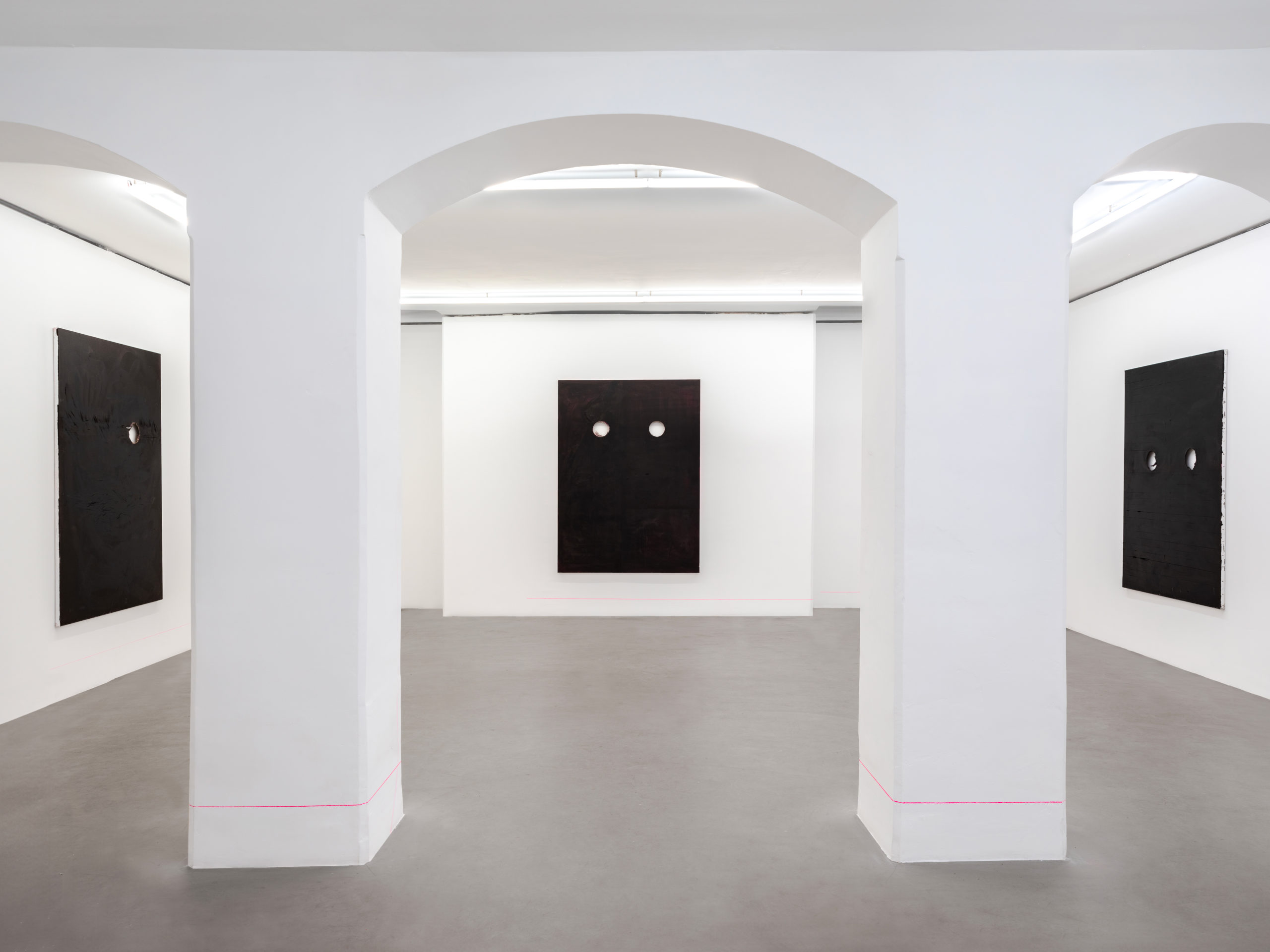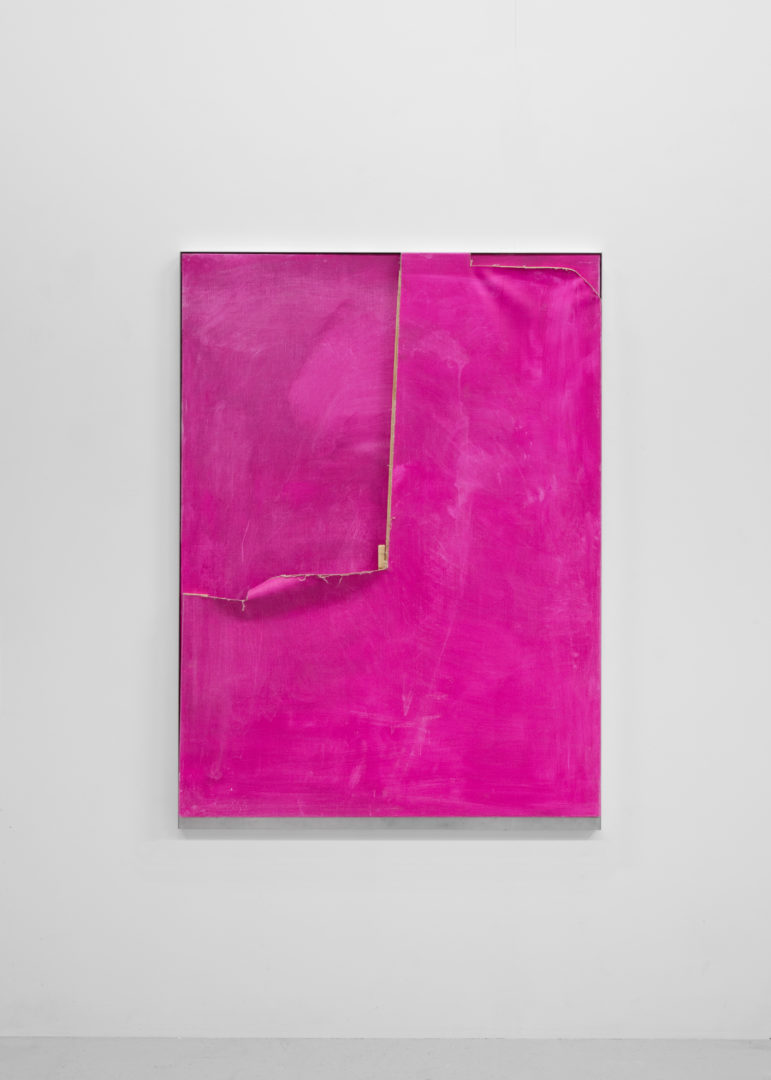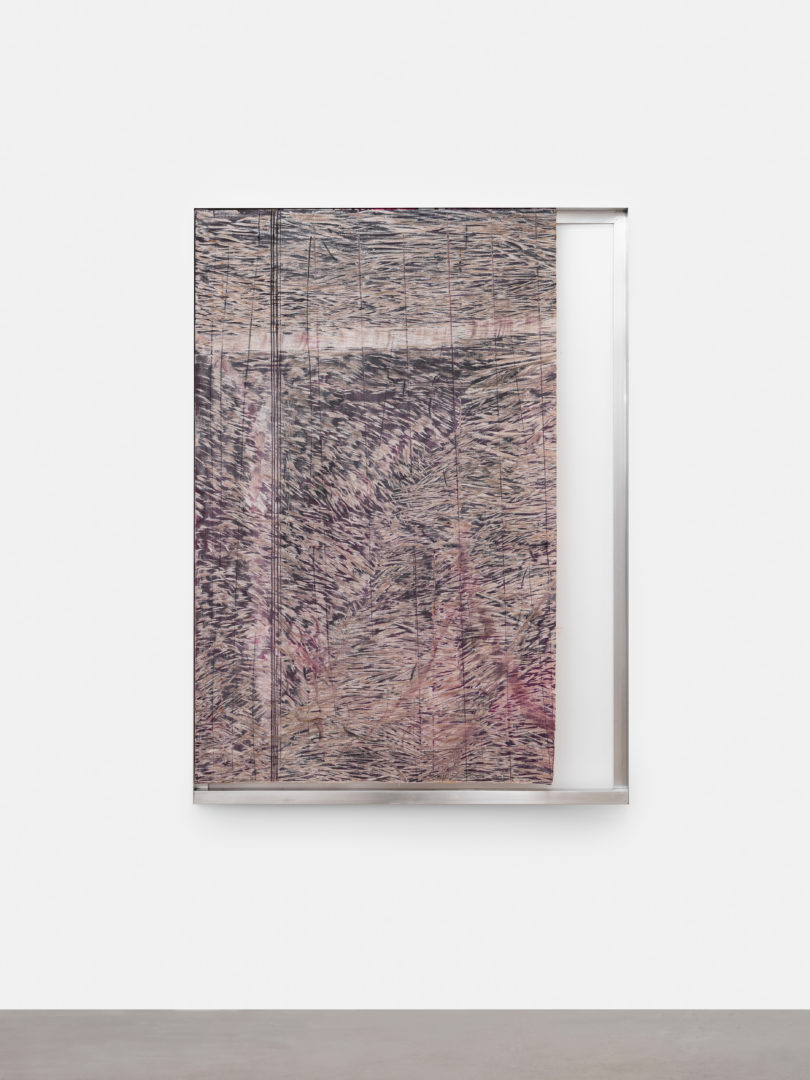Jonathan Binet at Balice Hertling gallery

“une rose est une rose est une rose” by Jonathan Binet
At Balice Hertling gallery
February 2nd – march 9th 2024
It is rare to see such an outstanding evolution in painting as that of Jonathan Binet. As a contemporary spin-off of Leon Battista Alberti famous interpretation of paintings as windows (1), the exhibition space at Balice Hertling reveals itself punctured by a multitude of openings looking onto abstract subjects. The paintings appear as solid anchors, containing explosive energies within their metal frames.
Binet’s prior work was deeply focused on the format, the size and composition of the frame, exploring its presence and absence through experimentation, repetition and reduction. In “une rose est une rose est une rose” this research seems obsolete, considering the prominent uniformity of the frames within the show – all measuring 134 x 98 cm (incidentally a standard size for Velux windows), are made of aluminum, with a rectangular shape thicker on the lower side base. The American architect John Hejduk would call such process an “exorcism”, where he would rid his work of external influences to the point of assimilating them to his own manner. Binet seems to do just that, liberating his frames in this series of outer references, and thus allowing for a fresh perspective on his work. Opting for a consistent, classic hanging method, he provides the viewer a visual rest, a well calculated and predictable experience, rhymed by the content within the frame rather than its form.

“une rose est une rose est une rose” is conceived as a continuation of Binet’s pictorial investigation into the conceptuality of the surface and its malleable flatness. Here, the paint gains depth, redefining the spatiality of the canvas. His adept manipulation of paint allows for an infinite layering of surfaces. His gesture fluctuates between adding (layers of paint, canvas pieces) and subtracting (removing layers of paint, canvas pieces). On some paintings he doubles the canvas – as seen in “No References” where a piece of canvas is affixed to a white, stretched canvas, while others “Focus” or “Untitled” are cut up, with entire corners missing. In “Pas d’chichi” the canvas is detached from its frame, floating, suspended only from the top and left edges. And then, comes the in-between: the paintings that bear both contrasting gestures within one surface, resulting in ripped canvases that remain attached around the entire perimeter of the frame. Some revealing Fontana-like slits as in the downstairs “Untitled” series, others expose peeking eye-like holes (“Cinderella’s Big Score”, “Untitled”) – the outcome of Binet’s intense handling of a sanding machine to scrape off paint from the surface. It is perhaps through this counter intuitive choice of tools that perspires the tension of his gesture, which must be both damaging and delicate to take effect.
The works are spread within the space in a calculated manner and in deliberate groups which guide the visitors across areas with more or less of the above-mentioned tension. Each painting emits a particular frequency defined by its surface, palette, and solidity, bringing the viewer into a state of seeing. The scenographic rhythm amplifies the various dispositions one might adopt when looking at the works. Entirely abstract, it is precisely through the full apprehension of their abstraction that the paintings transcend any projected figurative elements that might define them, and instead, plainly exist. They surpass the human inclination to impose visual interpretations. They are thus not what someone sees, and instead, simply are. A rose is a rose is a rose (2).
This simplicity permits a unique interpretation of the works, which bears no compulsion, nor precision. One can choose to see a landscape in “Pas d’chichi” or a figure in “No References”, without questioning the real purpose of the artist. In the same way, one can choose to find allusions to other artists — Jean-Pierre Pincemin’s “Palissades”, for instance, in the emerging grids of “Focus”, “Pas d’chichi”, “D”, “Untitled” ; or John Baldessari’s circles in the downstairs “Untitled” series ; or perhaps Mel Bochner’s “Measurement Rooms” in the pink line the artist traced along the gallery’s downstairs perimeter – all without assuming these were intentional references by Binet.
Jonathan Binet’s latest works show a remarkable completeness of subject and form. The use of pink, black and white adds an extra dimension to the aptly chosen title, which itself provides a key to understanding the exhibition.

(1) Leon Battista Alberti: On Painting, Cambridge University Press, 2011
(2) Gertrude Stein, Sacred Emily, 1913
______________________________________________________________________________
Head image : Jonathan Binet, une rose est une rose est une rose, 2024, Galerie Balice Hertling, Paris, exhibition view
- From the issue: 107
- Share: ,
- By the same author: Streaming from our eyes, Déborah Bron & Camille Sevez, Sanam Khatibi, Ho Tzu Nyen, GESTE Paris,
Related articles
Streaming from our eyes
by Gabriela Anco
Don’t Take It Too Seriously
by Patrice Joly
Déborah Bron & Camille Sevez
by Gabriela Anco

